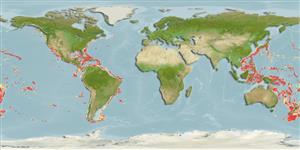Actinopterygii (peixes com raios nas barbatanas) >
Gadiformes (Cods) >
Macrouridae (Grenadiers or rattails) > Macrourinae
Etymology: Hymenocephalus: Named for its transparent membrane-like head covering (‘‘hymen head’’) and fragile nature of head bones (Ref. 100825). More on author: Gilbert.
Ambiente / Clima / Intervalo
Ecologia
; marinhas bentopelágico; intervalo de profundidade 340 - 1348 m (Ref. 58302). Deep-water, preferred ?
Widespread but patchy and discontinuous. Atlantic: Caribbean and continental slope of northern South America. Pacific: off subtropical western and eastern Australia, several islands in the southern Pacific (New Caledonia, Vanuatu, Wallis & Futuna, Marquesas Islands), and off Hawaii. Not recorded from eastern Atlantic nor Indian Ocean.
Tamanho / Peso / Idade
Maturity: Lm ? range ? - ? cm
Max length : 20.0 cm TL macho/indeterminado; (Ref. 37108)
Descrição suscinta
Morfologia | Morfometria
This species is distinguished by the following characters: a black-colored large-headed fish, with head size 21-25% TL; pelvic fin rays 13-14; pectoral fin rays 13-16; projecting snout, 20-24% HL; head bones are papery thin and often distorted; no barbel; small orbit diameter, 20-24% HL; interorbital width 60-70% HW; infraorbital width 20-25% HL; postorbital-preopercular interspace 10-14% HL; preopercular supporter is very small and forked; gill rakers 21-25; ventral striae reaching to about ? from pelvic fin bases to periproct; small otolith with rounded outline, no predorsal lobe developed; colliculi separated; otholith length to height (OL:OH), 1.0-1.2; total colliculum length to pseudocolliculum length (TCL:PCL) is 2.2-2.8 (Ref. 98298).
Found on the continental slope (Ref. 75154). Benthopelagic (Ref. 58302).
Life cycle and mating behavior
Maturidade | Reprodução | Desova | Ovos | Fecundidade | Larvas
Cohen, D.M., A.W. Ebeling, T. Iwamoto, S.B. McDowell, N.B. Marshall, D.E. Rosen, P. Sonoda, W.H. Weed III and L.P. Woods, 1973. Fishes of the western North Atlantic. Part six. New Haven, Sears Found. Mar. Res., Yale Univ. (Ref. 37108)
Status na Lista Vermelha da IUCN (Ref. 115185)
CITES (Ref. 94142)
Not Evaluated
Perigo para os humanos
Harmless
Uso pelos humanos
Mais informação
Nomes comunsSinônimosMetabolismoPredadoresEcotoxicologiaReproduçãoMaturidadeDesovaFecundidadeOvosDesenvolvimento dos ovos
Idade/TamanhoCrescimentoComprimento-pesoComprimento-comprimentoFrequências de comprimentoMorfometriaMorfologiaLarvasDinâmica larvalRecrutamentoAbundância
ReferênciasAquaculturaPerfil para aquaculturaEstirpesGenéticaFrequência alélicaHereditariedadeDoençasProcessamentoMass conversion
ColaboradoresFotosStamps, CoinsSonsCiguateraVelocidadeTipo de nataçãoÁrea branquialOtólitosCérebrosVisão
Ferramentas
Relatórios especiais
Baixar XML
Fontes da internet
